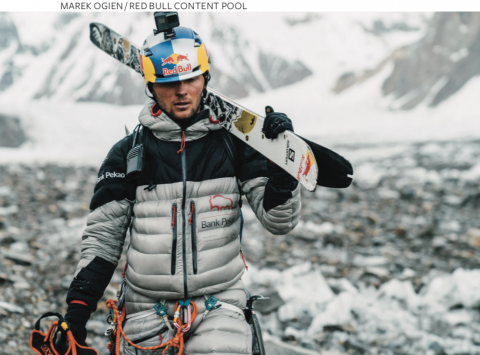
From the moment people figured out they could go downhill on skis and survive, they’ve been trying to be the first to ski from ever-higher mountains. Here are some of the biggest moments in first turns and first descents. By Jay Cowan
When 30-year old Polish ski mountaineer Andrzej Bargiel skied from the summit of K2 in July 2018, it was one of the last and greatest first full descents of the world’s highest peaks. At 28,251 feet in the Karakoram range of northern Pakistan, K2 is the second highest mountain on earth, and arguably the most challenging. To date, fewer than an estimated 450 people have summited it, compared to ten times that many on Mount Everest. And only a handful have been crazy enough to try skiing K2. When it finally happened it was instantly legendary, one of the true highlights of skiing’s longtime obsession with going higher.
Ski mountaineering at this level has evolved into a very specialized pursuit, demanding the best alpine gear and skills, along with extreme physical fitness, in order to survive at the very limits of human endurance: oxygen-thin air, polar temperatures and brutal winds, on slopes that are mostly insane. This isn’t some groomed black diamond at your local hill. Conditions vary from concrete sastrugi whitecaps to steep sheets of sheer ice, on gnarly couloirs and exposed faces, in the shadows of seracs, and across snowfields stitched with crevasses.
Bargiel, who soloed the climb and descent without oxygen, made one 150-foot rappel with his skis on at the top of the Bottleneck, where other skiers have died. “I’m very happy that I managed to ski down … safely … To be honest it was my second attempt, so I’m glad that I won’t be coming here again,” he declared at the base afterwards. This kind of ski mountaineering is clearly not about simple transportation or pleasure. It’s about constantly pushing the boundaries of yourself and the sport. But that wasn’t the reason high-altitude skiing began.
Once skiers started going downhill and liking it, they sought longer runs on higher mountains. As Lou Dawson notes in his seminal book Wild Snow (American Alpine Book Series, 1997), the early history of first descents in America often went unrecorded. That was also more or less true in the rest of the world. In Europe, those who first introduced skiing to their communities made many of the first descents and inspired others. But they didn’t start keeping close track of them until the skiing was combined with serious climbing and became part of a culture that noted, and celebrated, such things...
